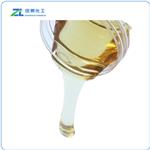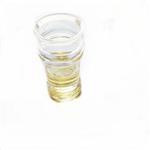Description
C16 palmitic: 8.0% palmitoleic; C18 stearic: 2.0% oleic, 82.0% linoleic, 8.0% linolenic; total saturated acids: 14%; total
monounsaturated acids: 77%; total polyunsaturated acids: 9%
Chemical Properties
clear yellow viscous liquid
Chemical Properties
Olive oil is the fixed oil obtained by cold expression or other
suitable mechanical means from the ripe drupes of Olea europaea. It
occurs as a clear, colorless or yellow, transparent oily liquid. It may
contain suitable antioxidants.
Refined olive oil is obtained by refining crude olive oil such that
the glyceride content of the oil is unchanged. A suitable antioxidant
may be added.
Uses
Olive oil is used in food of salads, with sardines, etc.; emollient; for treatment of leg ulcers; in the manufacturing of soaps, textile lubricants,
cosmetics, and pharmaceutical products.
Uses
Olive Oil is the oil obtained from the fruit of olive trees, olea europaea.
it is used mainly for salad and cooking oils.
Production Methods
Virgin olive oil is produced by crushing olives (the fruit of Olea
europaea), typically using an edge runner mill. The oil is then
expressed from the crushed mass solely by mechanical or other
physical methods under conditions that do not cause deterioration
of the oil. Any further treatment that the oil undergoes is limited to
washing, decantation, centrifugation, and filtration.
Refined olive oil is obtained from virgin olive oil by refining
methods that do not alter the initial glyceride content of the oil.
Definition
Extractives and their physically modified derivatives. It consists primarily of the glycerides of the fatty acids linoleic, oleic and palmitic.
General Description
Pale yellow oily liquid. Insolube in water and less dense than water. Hence floats on water. Contains principally glycerides of oleic, palmitic and linoleic acids.
Air & Water Reactions
Insoluble in water.
Reactivity Profile
Olive oil react with acids to liberate heat. Heat is also generated by interaction with caustic solutions. Strong oxidizing acids may cause a vigorous reaction that is sufficiently exothermic to ignite the reaction products. Flammable hydrogen is generated by mixing with alkali metals and hydrides. React slowly with oxygen in the air to become rancid.
Health Hazard
None-is a food.
Agricultural Uses
Olive oil is a clear, edible substance obtained from the
fruits of olive trees, the evergreen trees grown in
Mediterranean climates. The fruit is pulped, pressed and
finally extracted for oil. The best quality comes from the
fust pressing of just ripened fruits. The unripe fruits are
pickled, treated with a lye solution to remove the bitter
taste, and stored in brine. When left in the open, they turn
black and may be pressed thereafter for oil.
Pharmaceutical Applications
Olive oil has been used in enemas, liniments, ointments, plasters,
and soap. It has also been used in oral capsules and solutions, and as
a vehicle for oily injections including targeted delivery systems.
It has been used in topically applied lipogels of methyl
nicotinate.It has also been used to soften ear wax. Olive oil
has been used in combination with soybean oil to prepare lipid
emulsion for use in pre-term infants.
Olive oil is used widely in the food industry as a cooking oil and
for preparing salad dressings. In cosmetics, olive oil is used as a
solvent, and also as a skin and hair conditioner. Types of products
containing olive oil include shampoos and hair conditioners,
cleansing products, topical creams and lotions, and sun-tan
products.
Safety Profile
Moderately toxic by intraperitoneal route. A human skin irritant. Combustible when exposed to heat or flame; can react with oxidzing materials. Some spontaneous heating. To fight fire, use CO2, dry chemical. When heated to decomposition it emits acrid smoke and irritating fumes
Safety
Olive oil is used widely as an edible oil and in food preparations and
products such as cooking oils and salad dressings. It is used in
cosmetics and topical pharmaceutical formulations. Olive oil is
generally regarded as a relatively nonirritant and nontoxic material
when used as an excipient.
Olive oil is a demulcent and has mild laxative properties when
taken orally. It has been used in topical formulations as an emollient
and to sooth inflamed skin; to soften the skin and crusts in eczema;
in massage oils; and to soften earwax.
There have been isolated reports that olive oil may cause a
reaction in hypersensitive individuals. However, these incidences are
relatively uncommon.Olive oil is an infrequent sensitizer and
does not appear to be a significant allergen in the USA, possibly due
to the development of oral tolerance.
storage
When cooled, olive oil becomes cloudy at approximately 10°C, and
becomes a butterlike mass at 0°C.
Olive oil should be stored in a cool, dry place in a tight, wellfilled
container, protected from light.
For refined oil intended for use in the manufacture of parenteral
dosage forms, the PhEur 6.2 requires that the bulk oil be stored
under an inert gas.
Incompatibilities
Olive oil may be saponified by alkali hydroxides. As it contains a
high proportion of unsaturated fatty acids, olive oil is prone to
oxidation and is incompatible with oxidizing agents.
Regulatory Status
Olive oil is an edible oil. Included in the FDA Inactive Ingredients
Database (oral capsules and solution; topical solutions). Included in
nonparenteral medicines licensed in Europe. Included in the
Canadian List of Acceptable Non-medicinal Ingredients. For
nontopical uses, refined olive oil is generally preferred.



